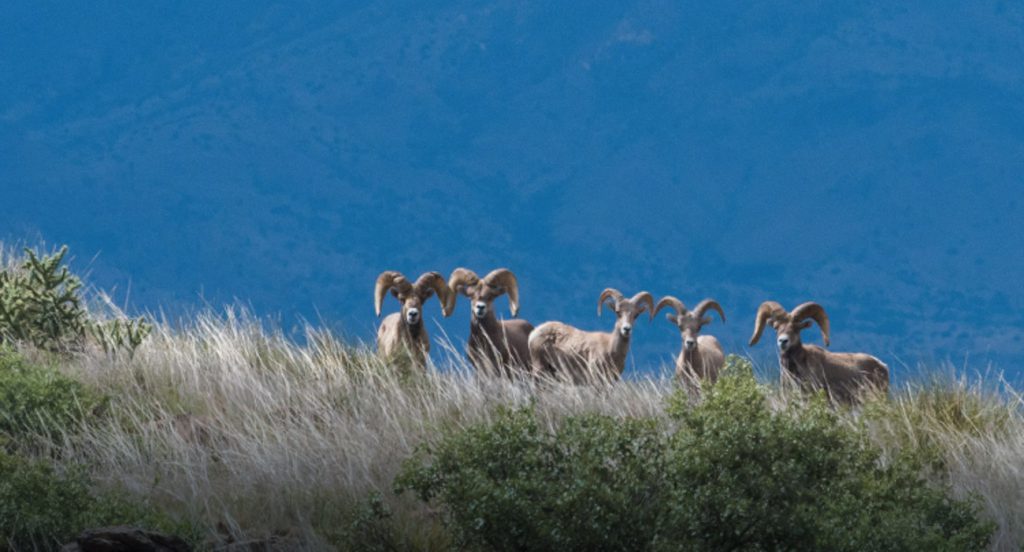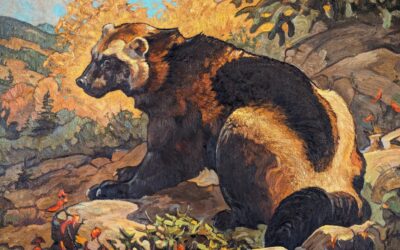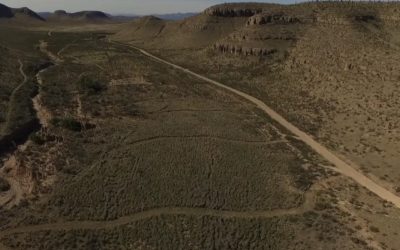Sheep on the Mountain
A great article from TWA. At Circle Ranch, we have enjoyed considerable success with Desert Bighorn. Here is our take on how to help these majestic animals get re-established in their native range:
- Increase water. Add a lot of water everywhere. Provide water in more locations and use “big drinkers” instead of guzzlers. More and bigger drinkers make it harder for predators to ambush sheep and they reduce the risk of disease and parasite transfer. Make drinkers and water supplies big enough to support large cattle herds and multiple wildlife species including quail and small animals.
- Refer to #1.
- Increase natural feed. Plants require animal impact such as grazing, trampling, and fertilization from dung and urine. Without bison, periodic planned cattle grazing supplemented by actions of wild grazers and browsers is essential to stimulate growth of natural feed and maintain habitat for bighorn, deer, pronghorn, elk and desert quail. Cattle profits will pay for water.
- Increase biodiversity. Bighorn are interdependent (symbiotic) with other prey species, predators, and large grazers. Bighorn—and all the others— cannot thrive without this full complement of animals.
- Mimic nature. Sheep can’t be grown like soybeans or feedlot cattle. Be very skeptical of wildlife “management” practices. Except for adding water and modifying fences, most suggested management strategies waste money and actually harm sheep and other wild animals over the long run – sometimes catastrophically. Dedicate the money you save by skipping these unnecessary measures to your water projects.
- Hunt lightly. Kill only old rams.
NOTE: this article below was published by Texas Wildlife Magazine as part of their July, 2018 issue. It was written by Henry Chappell.
Sheep on the Mountain
The first desert bighorns I ever saw—a half dozen rams with full curls, at least a thousand yards upslope, lying butt-to-butt in a circle like a covey of bobwhites—initially looked like a clump of deadwood. They resolved into sheep only when one moved his head.
I had already looked at them several times through a spotting scope without recognizing them. I kept looking only because Texas Parks and Wildlife Department (TPWD) biologist Clay Brewer, who’d spotted them through binoculars, assured me they were there. The sheep had no trouble spotting me, however. The three rams facing downslope were looking directly at me.
On that cold, windy February morning in 2003, at Elephant Mountain Wildlife Management Area (WMA), those few sheep struck me as a miracle of modern wildlife management. Three decades earlier, their ancient haunts in the desert mountains of far West Texas were as empty of sheep as of Native peoples who once hunted them with Stone Age weapons.
Bighorn sheep have lived in the desert mountains of the Southwest for at least 9,000 years. In less than 100 years, poaching, market hunting, net wire fencing and diseases introduced by domestic sheep wiped them out in Texas.
Biologists believe that in the late 1800s, about 1,500 desert bighorns roamed the mountain ranges of far West Texas. In 1900, after several expeditions into the Trans-Pecos region, Vernon Bailey, chief naturalist with the U.S. Biological Survey, estimated Texas’ native bighorn population at 500. He described their range:
“Mountain sheep inhabit the Upper Sonoran and Transition zones of the desert ranges of extreme western Texas. They are found in the Guadalupe Mountains. A few have been killed in the Eagle and Corozones mountains and on the northwest side of the Chisos Mountains. They come into the Grand Canyon of the Rio Grande mainly from the Mexican side. Mr. R.T. Hill reports specimens killed in the Diablo Mountains, 25 miles north of Van Horn. The sheep are by no means confined to isolated mountain ranges. In several valleys, I saw tracks where they had crossed from one range to another through open Lower Sonoran country.”
Legal hunting of bighorn sheep ended in 1903. By the mid-1940s, the population estimate stood at 35 animals. Restoration efforts began in 1945, when Texas acquired Sierra Diablo Wildlife Management Area in Hudspeth and Culberson counties as a sanctuary for the state’s remaining bighorn sheep.
In 1954 the Texas Game, Fish and Oyster Commission, U.S. Fish and Wildlife Service, Boone and Crockett Club, Wildlife Management Institute and Arizona Game and Fish Commission began cooperating to reverse the desert bighorn decline. But despite these heroic efforts, the last documented sighting of a native Texas bighorn occurred in October 1958 on the Sierra Diablo. The native bighorns were extirpated from Texas by the early 1960s.
As the native sheep population dwindled toward extinction, transplanted bighorns from other states offered the only hope for a viable population in Texas. From 1957 to 1959, TPWD stocked a 427-acre brood pasture at Black Gap WMA in Brewster County with 16 bighorns from Arizona. The herd increased to approximately 68 animals by 1970, then declined due to disease and predation. TPWD abandoned the operation at Black Gap WMA in 1978.
Meanwhile, from 1971 to 1978, three rams and five ewes from Black Gap were placed in an 8-acre pen on the Sierra Diablo WMA. From this nucleus, TPWD released seven sheep into the Sierra Diablo Mountains in 1973 and seven more in 1979.
TPWD’s bighorn program turned the corner in 1983, when Texas Bighorn Society members built and donated a new brood facility at Sierra Diablo WMA. Since then, more than 175 lambs have been raised and released into Texas’ mountains. In the late 1980s, wild-trapped bighorns from Utah and Nevada were released in the Van Horn and Baylor mountains.
In 1985, C.G. Johnson donated his 23,147-acre Elephant Mountain Ranch in Brewster County to the state to be used as a wildlife management area devoted to desert bighorn restoration and conservation.
In December 2000, helicopter crews using net guns caught 45 sheep at Elephant Mountain WMA. The captured animals were blindfolded and hobbled to minimize stress, then flown to an awaiting team of biologists and veterinarians. After being examined and fitted with tracking collars, the bighorns were placed in trailers and hauled to Black Gap WMA for release, essentially doubling the Black Gap population.
By 2003, about 500 wild, free-ranging desert bighorns roamed seven Texas mountain ranges: the Baylor, Beach, Sierra Diablo, Sierra Vieja and Van Horn mountains and the Black Gap and Elephant Mountain wildlife management areas. A small population also had moved into some of the more remote areas of Big Bend National Park.
Today, some 1,800 desert bighorns roam their historic range in the mountains of the Trans-Pecos. Barring a disease outbreak, that number should increase.
“So far, sheep have been restored to 11 of the 18 mountain ranges that make up their historic territory,” said TPWD Bighorn Program Leader Froylan Hernandez. “We’d like to grow it to 2,000-plus. We’re a little more than halfway there with having all the habitat restored.”
Since 2010, all capture and translocation has involved free-ranging Texas-born sheep.
As their name suggests, desert bighorns are perfectly adapted to the high, arid, sparsely vegetated desert mountains. The bighorn’s primary defenses against predators are keen eyesight, an unobstructed view and quick escape up steep slopes.
The Trans-Pecos region often suffers severe drought. Since 2000, bighorn numbers have increased during periods when mule deer and pronghorn antelope numbers fell. Although desert bighorns can survive without standing water, Brewer and his colleagues believe that guzzlers, artificial rainwater collection basins, help ensure that the small, isolated populations avoid severe drought-induced stress. The extra water benefits numerous other species as well.
Bighorns are gregarious and loyal to their home ranges. Mixed bands of 15 or so rams and ewes are typical during spring and summer. During fall and winter, rams form bachelor groups while 40 or more ewes and lambs are common.
In Texas, lambing usually occurs in January and February, though lambs are sometimes seen as early as November and as late as April. In the winter, lambs and ewes inhabit prime steep and rocky habitat while groups of rams use marginal habitat at lower elevations. Ewes typically give birth to one lamb, although twins occasionally occur.
In Texas, bighorns vary in color from light gray to tan with conspicuous white rump patches. Ewes tend toward lighter colors while rams grow darker with age. Adults range from
30 to 39 inches at the shoulder. Rams average 160 pounds; ewes average 96 pounds. Mature rams (7 years old+) have thick necks and carry massive, curled horns—sometimes fully curled and beyond; ewes have much thinner horns that rarely achieve a half curl.
Vernon Bailey’s description, in Biological Survey of Texas, 1899-1905, of the hooves of an old ram taken in the Guadalupe Mountains explains the bighorn’s ability to run up nearly-vertical slopes:
“While the points and edges of the hoofs are of the hardest horn, the deep, rounded heels are soft and elastic — veritable rubber heels — with a semi-horny covering over a copious mass of tough, elastic, almost bloodless and nerveless tissue… It is easy to see how they would fit and cling to the smooth surface of a sloping rock where wholly hard hoofs like those of a horse would slip…”
Yet, for all their nimbleness, bighorns can’t escape one of the desert’s most common hazards. Baily continued: “The legs of the sheep secured were filled, especially below the knee, with cactus and agave thorns that had gone through the skin and broken off in spikes half an inch to an inch long and lodged against the bone or inner surface of the skin.”
Sheep restoration and conservation cost big money, and hunters pay the bill. Support comes from the Federal Aid in Wildlife Restoration Program (Pittman-Robertson tax on sporting arms and ammunition), TPWD’s annual four-species Grand Slam hunt drawing, and donations of time and money by the Texas Bighorn Society and the Wild Sheep Foundation.
Texas bighorns gained their most ardent support in the early 1980s when a group of dedicated big game hunters formed the Texas Chapter of the Federation of North American Wild Sheep (FNAWS) and the Foundation for the Texas Bighorn Society. In 1985, the two groups merged to become the Texas Bighorn Society (TBS).
Since its inception, the TBS has donated millions to the desert bighorn recovery effort. TBS members don’t simply write checks. Through annual work projects, members help build and maintain water guzzlers and other facilities, set up Web cams and assist with sheep transplants. Materials, equipment and personnel must be flown by helicopter to remote work sites. The group also provides solar-powered telemetry collars and other research equipment.
TPWD issues sheep-hunting permits based on annual helicopter surveys of bighorn populations. In recent years, around 15 permits were issued. One of these goes to a private organization such as the Texas Bighorn Society, Dallas Safari Club or TWA to be auctioned for sheep conservation. Three go to the state for the Grand Slam draw. Most of the rest go to landowners.
In recent years, auctioned permits have gone for $80,000 to $120,000. Ninety percent of the auction funds goes for bighorn conservation in Texas. “In recent years, the auction price has been higher because of better quality rams, and the fact that hunter success runs about 95 percent,” Hernandez said. “Without those auction funds, we couldn’t begin to fly surveys, trap and stock.”
Hernandez estimates that, considering donated labor as well as money, outside contributions toward sheep conservation amount to around $200,000 per year.
About 94 percent of the land in Texas is private property. Although state wildlife management areas provided habitat for the initial phases of bighorn recovery, continued success would have been impossible without enthusiastic cooperation of private landowners.
Clay Brewer, who became conservation director of the Wild Sheep Foundation after retiring from TPWD in 2016, wrote many of the original landowner agreements.
“The bottom line is that we couldn’t have achieved anywhere near this kind of success without our landowners,” he said. “Many of these folks belong to families that have been on the land for more than a century. I’m very proud of those relationships and count that work as some of the most satisfying I’ve done.”
Hernandez said, “The next step is to go to mountain ranges that are within private property. On the surface, it might seem like we’re just stocking private ranches, but these ranges are not all fenced in. The sheep are able to go to other places. We have to realize that the majority of the remaining habitat is private property.”
Jim Bean’s family land borders Sierra Diablo WMA. Although the ranch has never received direct stocking, a stable population developed from bighorns moving in from the WMA.
“It’s rare that you go out driving on our place and not see bighorns,” the El Paso businessman said. “Nearly all of the landowners who have sheep are behind the program. They know that sheep are finicky and highly vulnerable to disease that could come through and wipe out an area. We all want sheep over the maximum range so that our ranches could be repopulated by sheep from other areas. Ranchers also offer mule deer hunts for auction to raise money for sheep management, and during water shortages they’re always ready to step up and help.”
Jim Payne, president of the Texas Bighorn Society, admits that of all the obstacles bighorn manager face, the threat of disease worries him most. Thus far, Texas’s population has been spared the devastating outbreaks that have hit wild sheep in other parts of the country.
Payne said, “So far, we’ve avoided outbreaks caused by domestic sheep because our bighorns are so isolated. But there are other naturally-occurring diseases out there that could be disastrous.”
To address the threat, TBS recently partnered with Texas Tech University on an ambitious disease and genetics study.
“We hope to eventually understand why the sheep in one mountain range might be more susceptible to a particular disease than those in another range,” he said. “Our ultimate goal is to not simply grow sheep, but to grow healthy sheep.”
Clay Brewer, summed up the mantra of those working to conserve and increase Texas’s desert bighorn population, “Our job is to put sheep on the mountain, pure and simple.”
By any measure, he and his colleagues have done their job.




Love reading anything Bighorn related! Awesome animals that live in some crazy country.
Thank you Justin. They are amazing animals.